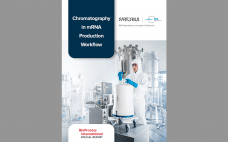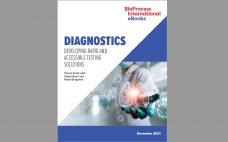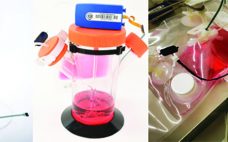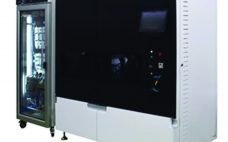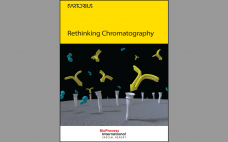Rapid response to global pandemics requires the manufacture of billions of vaccine doses within months. This short timeline must allow for design and testing of active ingredients, development of production and purification processes, clinical evaluations, regulatory filings, and manufacturing. Existing purification methods often have been adopted from laboratory-scale techniques to allow rapid implementation, and those have provided adequate product quality. But future mRNA development will require optimized production and purification processes. Chromatography has been a workhorse of biomanufacturing for decades,…
2021
Tris, a Critical Raw Material: Improving the Quality and Consistency of Supply
ANGUS Life Sciences is the world’s largest supplier of tromethamine buffers and the only manufacturer of the tris molecule based in the Western hemisphere. The company sells directly to biopharmaceutical customers and contract manufacturing organizations as well as to reprocessors who repackage the chemical or process it into different grades and derivatives. After recent expansions in both the United States and Germany, the company now boasts dual-source manufacturing capabilities for its highest-purity tris products and is confident about its ability…
Protecting Artificial Intelligence Inventions in Drug Development
Artificial intelligence (AI) is a lot more sophisticated today than it was just a few years ago. Its impacts are felt outside of technology applications such as computing, malware, and natural language processing. For example, Google’s AI (called DeepMind) recently solved one of biology’s greatest problems: It determined a protein’s three-dimensional shape from its amino acid sequence. Now, AI is making a foray into drug development processes. Drug development is a risky, expensive, time-consuming, yet often lucrative venture. The costs…
eBook: Diagnostics — Developing Rapid and Accessible Testing Solutions
The COVID-19 pandemic has brought myriad economic disruptions, social complications, and public-health calamities to the world. They have understandably overshadowed the silver lining of boosting biomedical science and technology in the realms of infectious disease, oncology, and more. But alongside the much-publicized commercial debut of novel vaccine technologies have come promising advances in medical diagnostics. In this eBook, BPI’s senior technical editor brings together perspectives from industry, academia, and expert organizations to highlight some of the latest diagnostic methods and…
Working with Big Data in Healthcare and Bioprocessing Settings: A Brief Introduction to Key Components and Considerations
Artificial intelligence (AI) in healthcare and biopharmaceutical industries still is in early stages of development and use, yet proper data management is critical to successful implementation at any stage of the enterprise continuum. AI is applied to help researchers understand and analyze biology, diagnose diseases, design new drugs, and predict clinical potential and treatment outcomes. AI has been applied in the discovery and development of novel drugs and for repurposing existing drugs, manufacturing different types of drug products, and optimizing…
Pathogen Safety Digital Platform for Biopharmaceuticals: The Journey from Ground to Cloud
Digital transformation is at the heart of many biopharmaceutical companies’ strategies for ongoing success. However, the definition of digital transformation and what it consists of differ within the bioprocess industry (and might even vary within a single company), specifically as it applies to the overall value chain from R&D to clinical trials, manufacturing, supply chain, and eventually commercial operations. To provide a perspective on what digital transformation could look like in bioprocessing, we present a case study about an exploratory…
Automated Process Control Based on In Situ Measured Glucose Concentration
A process analytical technology (PAT) strategy involves defining critical process parameters (CPPs) of a biomanufacturing process that influence critical quality attributes (CQAs) and controlling those CPPs within defined limits. Doing that enables consistent product quality and helps companies reduce waste and costs. Glucose is an important CPP in bioprocessing and cell therapy. Glucose often is fed as a bolus addition based on daily off-line measurements, but that can lead to high glucose fluctuations and to excessive glucose feeding, which can…
Realization of Quality By Design and Beyond: The Intelligent Cell Processing System
Cells are used as raw materials, intermediates, and final products in biopharmaceutical and cell therapy manufacturing. Because living cells are always in a dynamic state, their characteristics must be kept within specified ranges throughout bioprocessing to preserve their utility. Cell population expansion without changing the original cell properties is key for obtaining the required number of cells at the next step. However, limited process data are collected during the expansion phase — information that could be used to understand and…
Rethinking Chromatography
Dynamic trends in the biotherapeutic industry are shifting manufacturers towards new modalities and intensified production strategies. This development is supported by ongoing scientific and technical advances in both upstream and downstream processing steps. Downstream processing of new modalities requires chromatography technologies that can handle large, fragile molecules (such as mRNA and viral particles). To maximize speed and productivity, platforms supporting continuous processing will become essential. In this feature, Sartorius discusses current and future concerns for process chromatography operations. They then…
Get High-Throughput, Definitive Identification of Viable Cells and More in Your Cell Therapy
Analyzing for viable cells using traditional methods such as flow cytometry often encounters clogging resulting in the loss of precious cell therapy samples. Not only is it low throughput, but incredibly complicated, which can lead researchers to misidentify cellular and non-cellular material and confuse cell viability results with product-purity issues. Additionally, it is a regulatory requirement for all injectable drug products be characterized for sub visible particles (SVP) and aggregates that may form during a manufacturing process. With Backgrounded Membrane…

